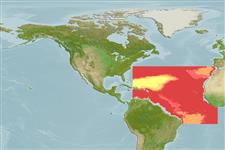>
Notacanthiformes (Halosaurs and deep-sea spiny eels) >
Halosauridae (Halosaurs)
Etymology: Aldrovandia: Taken from Ulisse Aldrovandi, (1522-1605), a Renaissance naturalist and physician noted by his systematic and accurate observations of plants and animals (Ref. 45335).
Eponymy: Dr Ulisse Aldrovandi (1522–1605) was an Italian naturalist. [...] (Ref. 128868), visit book page.
Environment: milieu / climate zone / depth range / distribution range
Ecologia
marinhas batipelágico; intervalo de profundidade 1200 - 1900 m (Ref. 4448). Deep-water; 37°N - 9°S, 74°W - 6°W
Eastern Atlantic: Gulf of Guinea region. Western Atlantic: off Virginia, USA to Bahamas, Venezuela and the Guianas. Eastern Central Pacific (Ref. 9305) and Chile (Ref. 9068).
Tamanho / Peso / Idade
Maturity: Lm ? range ? - ? cm
Max length : 52.0 cm TL macho/indeterminado; (Ref. 4448)
Raios dorsais moles (total) : 9 - 10. Anus white, surrounded by dark field; body dark brown, head black (Ref. 13608).
Found at bathyal depths. Feeds on polychaetes. Males exhibits black tubular anterior nostrils and enlarged posterior nostrils when approaching breeding condition.
Life cycle and mating behavior
Maturidade | Reprodução | Desova | Ovos | Fecundidade | Larvas
Sulak, K.J., 1990. Halosauridae. p. 126-132. In J.C. Quero, J.C. Hureau, C. Karrer, A. Post and L. Saldanha (eds.) Check-list of the fishes of the eastern tropical Atlantic (CLOFETA). JNICT, Lisbon; SEI, Paris; and UNESCO, Paris. Vol. 1. (Ref. 4448)
Categoria na Lista Vermelha da IUCN (Ref. 130435: Version 2024-1)
Ameaça para o homem
Harmless
Utilização humana
Pescarias: sem interesse
Ferramentas
Relatórios especiais
Descarregue XML
Fontes da internet
Estimates based on models
Preferred temperature (Ref.
123201): 4.2 - 6.5, mean 4.3 °C (based on 37 cells).
Phylogenetic diversity index (Ref.
82804): PD
50 = 0.5156 [Uniqueness, from 0.5 = low to 2.0 = high].
Bayesian length-weight: a=0.00085 (0.00033 - 0.00223), b=3.07 (2.84 - 3.30), in cm total length, based on LWR estimates for this (Sub)family-body shape (Ref.
93245).
Nível Trófico (Ref.
69278): 3.1 ±0.26 se; based on food items.
Resiliência (Ref.
120179): Baixo, tempo mínimo de duplicação da população 4,5 - 14 anos (Assuming tmax>10).
Fishing Vulnerability (Ref.
59153): Moderate vulnerability (41 of 100).
